|
Please note, if you don't have access to the print edition of The Weekly, a PDF download of this two-page map is available by clicking here. -- Ed.
Three-hundred and sixty-eight. Everyone invested in Jeju knows the significance of the number. It’s the amount of oreum, or volcanic cones, dotting the island’s landscape.
Some oreum are lined with pristine hiking trails, others are overrun with cattle. Some have no real paths, others are manned with fire watchers. Some are closed temporarily, others are closed indefinitely. Ownership spans from private, to public, to a mix of both, to incorporated foundation, military or other.
Most oreum are not fit or designed to safely accommodate hikers. Special is the one word describing most of the approximately 100 that are able to be traversed.
As the third and last segment of The Weekly’s Hike Jeju series, the author became familiar with 135 oreum, hiking the majority of those in the final three weeks. The rest were evaluated during Part 1’s Olle trails and Part 2’s Hallasan National Park trails. The entire project spanned 54 hiking days interspersed with a few rest days.
What makes a hiking oreum great?
No two hiking oreum are alike. The amount of actual trails and hiking time increases an oreum’s greatness. The type of vegetation and landscape the path weaves a hiker through is equally important, as are the views at the respective peak or peaks.
Any type of English interpretation — in the form of a translated sign, guide, pamphlet, available information or pictures on the Internet — is a helpful aid.
Most importantly: is the oreum recommended to a like-minded individual soon after finishing?
Preservation and conservation may be the next heavily-talked-about topics concerning oreum with increasing use and wear for the natural wonders with no chance to reproduce. What is presently there for oreum is all there is.
(Design by Lee Miri. Edited by Todd Thacker)
Jeju’s top 5 hiking oreum
No. 1 Geomun Oreum
| |
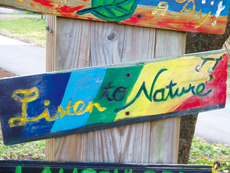 |
|
| ▲ Photo by Steve Oberhauser |
Jeju’s best has to be Geomun Oreum, located off road 97 in Jocheon. Earning UNESCO designation, Geomun’s trails are perfectly maintained covering nine dragon peaks, and the amount of hikers are limited per day on a reservation basis, with a guide interpreting the first interior segment of the trail. The total amount of hiking time is about four hours.
An A and B course exist after the visitor center. However, the B course, was only open for less than two months last summer.
No. 2 Seongsan Ilchulbong
| |
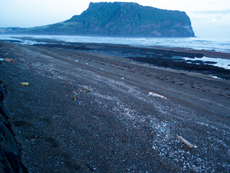 |
|
| ▲ Photo by Steve Oberhauser |
Another UNESCO site, known as Sunrise Peak in English, is the place where floods of tourists go. Despite its overuse and commercialization at the base, the geological, cultural, and historical importance of this island’s eastern landmark cannot be denied.
About a 30- to 45-minute hike up to the top, a hiker can see the massive crater and look east toward the Pacific Ocean. Perfect for watching the sunrise, as the name implies. Probably the most English information exists about this volcanic structure on Jeju than any other.
No. 3 Sanbangsan
| |
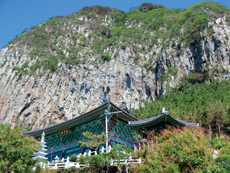 |
|
| ▲ Photo by Steve Oberhauser |
Perhaps one of the island’s most distinguishable features, located in Daejeong on the southwestern coast, it towers above everything else. Possessing a Buddhist temple, and a cave grotto, Sanbangsan’s magnificence is pronounced and can be attributed to it being convincingly within the viewers’ eyes anywhere near that part of the island.
Although no official trail goes to a peak, some hikers have been able to scurry up unabated.
No. 4 Donggeomun (comprised of Geomi and Munseoki oreum)
| |
| |
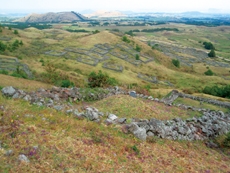 |
|
| ▲ Photo by Steve Oberhauser |
|
|
| ▲ Photo by Steve Oberhauser |
While the top 3 are gimmes, Donggeomun takes a hiker to another place, its teleportation abilities are perfect to leave a hiker feeling alone, perhaps mystical.
The rough and raggedness of its trails and scale of its two of many peaks looking down deep into a valley and around at the super-sized, wall-enclosed graveyards presents an experience like no other. With several access points, it is still hard to get to, about three kilometers south of Bijarim Forest.
No. 5 Ddrabi
| |
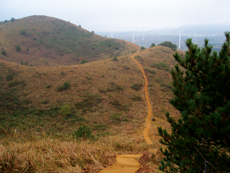 |
|
| ▲ Photo by Steve Oberhauser |
As one of the island’s lesserknown oreum, Ddrabi is for the enire family. Its crater walking path at the summit is the best of all oreum, and the views, again, are of another world.
It’s a short jaunt to the top, from the well groomed parking lot, toilets, and entryways.
Able to be accessed from a farm road (south of 1112) off of road 1136, Ddrabi is a dark horse, it will increase in popularity as time elapses and more people talk about its power.
Jeju’s lesser known top 5 hiking oreum
Mulyeongari Oreum
| |
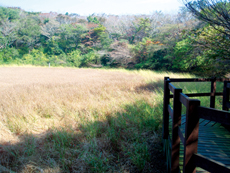 |
|
| ▲ Photo by Steve Oberhauser |
A Ramsar-designated wetland, the crater and the steep walk up is a must for any nature lover. A guide is present with a small visitor center. Found on road 1118 well north of Pyoseon, Mulyeongari is a welcomed break from the ordinary oreum.
What is different is the entire wood walkway up, with a few benches for breaks and the entire enclosure at the top is small, but the protected part opens up to the island’s wetland wildlife paradise.
Baekyaki Oreum
| |
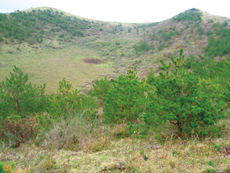 |
|
| ▲ Photo by Steve Oberhauser |
A part of Gujwa’s incredible cluster, just across from Donggeomun, it is figuratively overshadowed by noteworthy Abu Oreum. However, Baekyaki is certainly the place to go before Abu. Its rustic path rises. Most impressive is not the length of the crater walk or the sights within, but all the varying views looking out from the peak’s perimeter.
Baekyaki, on the basis of spot discussions with Koreans, seems to be the least known of the great ones. When there, locals only were present, despite its easy route to the entrance.
Nokkomaekeun Oreum
| |
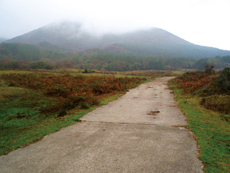 |
|
| ▲ Photo by Steve Oberhauser |
Located in a string with three other oreum, just east of road 1135 and south of 1117, Nokkomae keun encompasses a hiking path of at least 10 kilometers in length. Its peak height of 830 meters, is larger than the surrounding non-park oreum. Views abound, however, chances are they will be disturbed by fog or cloud cover.
The beauty of Nokkomae keun lies in the length of its initial trail, first heading through horses, then cemeteries, heavy brush, and on toward the amphitheater-type seating area at the summit.
Byeongak / Sobyeongak
| |
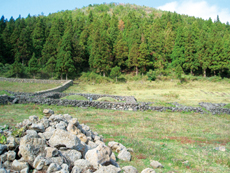 |
|
| ▲ Photo by Steve Oberhauser |
Suffering only from its cattle-trodden paths, this duo is something else. Found in the remote and desolate area of Sangcheon-ri east of road 1139 and northeast of Andeok, the steepest paths are found here. One has to grab both ropes on each side to ascend the non-fire watching peak. Wend down and around to the second peak. So many paths exist here, multiple visits are possible.
The force of these two are a different breed of hiking experience. A choose-your-own adventure of rate and usage.
Dangsanbong / Dangsanbong Al Oreum
| |
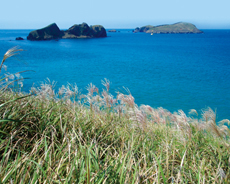 |
|
| ▲ Photo by Steve Oberhauser |
Overlooking Chagwido and its adjacent islands is the best spot on the island’s west coast. Perhaps passed up because Suwolbong is close and easier to get to. Dangsangbong and its little sibling oreum, is not only more wild, its path goes around and offers multiple views of the islands. This is near the last stretch of Olle Course No. 12. A lot of farmland and a private structure are seen during parts of walking. The Olle path cuts straight through the best part of the oreum toward a north port.
|






























